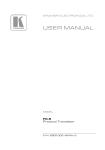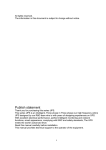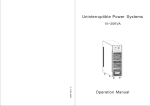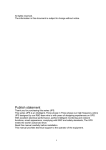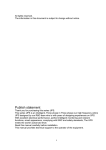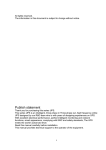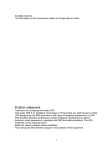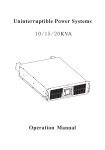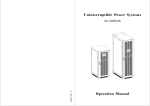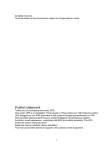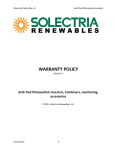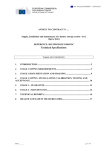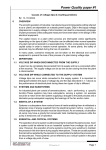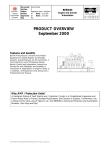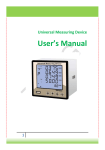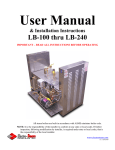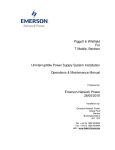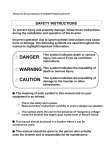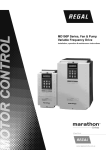Download User Manual
Transcript
All rights reserved. The information in this document is subject to change without notice. Publish statement Thank you for purchasing this series UPS. This series UPS is an intelligent, Three phase in Three phase out, high frequency online UPS designed by our R&D team who is with years of designing experiences on UPS. With excellent electrical performance, perfect intelligent monitoring and network functions, smart appearance, complying with EMC and safety standards, The UPS meets the world’s advanced level. Read this manual carefully before installation This manual provides technical support to the operator of the equipment. 0 Contents 1.Safety............................................................................................................................................................ 2 1.1 Safety notes ....................................................................................................................................... 2 1.2 Symbols used in this guide............................................................................................................ 2 2.Main Features ............................................................................................................................................. 3 2.1 Summarization................................................................................................................................... 3 2.2 Functions and Features .................................................................................................................. 3 3.Installation................................................................................................................................................... 4 3.1 Unpack checking............................................................................................................................... 4 3.2 The appearance of the product ..................................................................................................... 4 3.4 LCD control panel ............................................................................................................................. 9 3.5 Installation notes............................................................................................................................. 10 3.6 External Protective Devices ......................................................................................................... 11 3.7 Power Cables ................................................................................................................................... 11 3.8 Power cable connect...................................................................................................................... 12 3.9 Battery connection ......................................................................................................................... 13 3.10 UPS Multi-Module Installation ................................................................................................. 15 4.Operation ................................................................................................................................................... 16 4.1 Operation Modes............................................................................................................................. 16 4.2 Turn on/off UPS ............................................................................................................................... 17 4.3 The Display ....................................................................................................................................... 20 4.4 Options .............................................................................................................................................. 24 Appendix 1 Specifications .......................................................................................................................... 26 Appendix 2 Problems and Solution .......................................................................................................... 28 Appendix 3 RS232 communication port definition............................................................................... 30 Appendix 4 USB communication port definition .................................................................................. 31 Appendix 6 LBS communication port definition ................................................................................... 33 Appendix 7 BAT_T communication port definition .............................................................................. 34 Appendix 8 Drycontact port definition..................................................................................................... 34 Appendix 9 REPO instruction .................................................................................................................... 35 1 1.Safety Important safety instructions – Save these instructions There exists dangerous voltage and high temperature inside the UPS. During the installation, operation and maintenance, please abide the local safety instructions and relative laws, otherwise it will result in personnel injury or equipment damage. Safety instructions in this manual act as a supplementary for the local safety instructions. Our company will not assume the liability that caused by disobeying safety instructions. 1.1 Safety notes 1. Even no connection with utility power, 220/230/240VAC voltage may still exist at UPS outlet! 2. For the sake of human being safety, please well earth the UPS before starting it. 3.Don’t open or damage battery, for the liquid spilled from the battery is strongly poisonous and do harmful to body! 4.Please avoid short circuit between anode and cathode of battery, otherwise, it will cause spark or fire! 5.Don’t disassemble the UPS cover, or there may be an electric shock! 6.Check if there exists high voltage before touching the battery 7.Working environment and storage way will affect the lifetime and reliability of the UPS. Avoid the UPS from working under following environment for long time ◆ Area where the humidity and temperature is out of the specified range(temperature 0 to 40℃, relative humidity 5%-95%) ◆ Direct sunlight or location nearby heat ◆ Vibration Area with possibility to get the UPS crashed. ◆ Area with erosive gas, flammable gas, excessive dust, etc 8.Keep ventilations in good conditions otherwise the components inside the UPS will be over-heated which may affect the life of the UPS. 1.2 Symbols used in this guide WARNING! Risk of electric shock CAUTION! Read this information to avoid equipment damage 2 2.Main Features 2.1 Summarization This series UPS is a kind of three-in-three-out high frequency online UPS, it provides seven specifications: The 200~500kVA. The UPS can solve most of the power supply problems, such as blackout, over-voltage, under-voltage, voltage sudden drop, oscillating of decreasing extent, high voltage pulse, voltage fluctuation, surge, inrush current, harmonic distortion (THD), noise interference, frequency fluctuation, etc.. This UPS can be applied to different applications from computer device, automatic equipment, communication system to industry equipment. 2.2 Functions and Features ◆3Phase In/3Phase Out UPS It is 3Phase In/3Phase Out high-density UPS system, of which input current is kept in balance. No unbalance problem might occur. ◆Digital Control This series UPS is controlled by Digital Signal Processor (DSP); enhance, it increases reliability, performance, self-protection, and self-diagnostics and so on. ◆Battery Configurable from 32 blocks to 40 blocks The battery voltage of this series UPS can be configured at 32 blocks, 34 blocks, 36 blocks, 38 blocks or 40 blocks according to your convenience. ◆Charging Current is configurable The user may set the capacity of the batteries as well as reasonable charging current. Constant voltage mode, constant current mode or floating mode can be switched automatically and smoothly. ◆Intelligent charging Method The series UPS adopts advanced three-stage charging method— 1st stage: high current constant current charging To guarantee to charge back to 90%; nd 2 -stage: Constant Voltage In order to vitalize battery and make sure batteries are fully charged rd 3 stage: floating mode. With this 3-stage charging method, it extends the life of the batteries and guarantees fast charging. ◆LCD Display With LCD plus LED displays, the user may easily get UPS status and its operational parameters, such as input/output voltage, frequency & load%, battery % and ambient temperature, etc... ◆Intelligent Monitoring Function Via optional SNMP Card, you may remotely control and monitor the UPS. ◆EPO Function The series UPS may be completely shut off when the EPO is pressed. REPO function 3 (Remote EPO) is also available in this series UPS. 3.Installation 3.1 Unpack checking 1. Don’t lean the UPS when moving it out from the packaging 2. Check the appearance to see if the UPS is damaged or not during the transportation, do not switch on the UPS if any damage found. Please contact the dealer right away. 3. Check the accessories according to the packing list and contact the dealer in case of missing parts. 3.2 The appearance of the product 200kVA: Front View Side View 4 Rear View Front View(internal) Rear View(internal) 250/300kVA: 5 Front View Side View Front View(internal) 400/500kVA: 6 Rear View Rear View(internal) Front View Side View Front View(internal) Rear View Rear View(internal) (1) LCD panel : LCD and LED display (2) Front lock (3) Lightning arrester cover plate : Remove cover plate to replace lightning arrester (4) Bypass switch cover plate : Remove cover to operate bypass switch (5) Dustproof net plate (6) Fuse Box : Input fuses and Battery fuses inbuilt, box 1 connected to module 1 (7) Communication panel (8) I/P Switch (9) Maintenance switch (10) Maintenance switch cover : Remove cover UPS transfers to Maintenance (11) Input/Output Terminal cover : Remove cover to operate wire (12) O/P Switch (13) Lightning arrester (14) Parallel port 1/2 (15) The input filter capacitor switch : connect capacitor or not (16) Bypass Switch (17) Update RS485 port : use to update UPS software 7 (18) LBS port (19) Tools box : parallel cable, user manual, switch handle Communication panel: (1) Communication panel fixed screw (2) Intelligent slot 1 : insert SNMP card or Dry contact card (3) Intelligent slot 2 : insert SNMP card or Dry contact card (4) RS485 port 1/2 (5) BAT_T port 1/2 : connect battery temperature sensor box (6) Black start button : start UPS by battery without AC input (7) EPO button (8) REPO port : Remote EPO connect port (9) RS232 port (10) USB port (11) Dry contact port : Pin1-12Vdc, Pin2- DRY_GENER , Pin3- BP_O, Pin4- BP_S Parallel port: 200/250/300kVA Terminal Block: 400/500kVA Terminal Block: 8 Infront of the UPS Back of the UPS Dustproof net plate: 1-6:Dustproof net plate fixed screw 3.4 LCD control panel LCD control panel introduction (1)LED(from top to bottom: “mains output”, “bypass output”、“battery output”、“alarm”) 9 (2)LCD display (3)Function button 3.5 Installation notes Note: Consider for the convenience of operation and maintenance, the space in front and back of the cabinet should be left at least 100cm and 80cm respectively when installing the cabinet. ◆Please place the UPS in a clean, stable environment; avoid the vibration, dust, humidity, flammable gas and liquid, corrosive. To avoid from high room temperature, a system of room extractor fans is recommended to be installed. Optional air filters are available if the UPS operates in a dusty environment. ◆The environment temperature around UPS should keep in a range of 0 ℃ ~40 ℃. If the environment temperature exceeds 40 ℃, reduced be the ratedbyload 12% capacity per should 5 ℃. The m ax temperature can't be higher than 50℃. ◆If the UPS is dismantled under low temperature, it might be in a condensing condition. The UPS can't be installed unless the internal and external of the equipment is fully dry. Otherwise, there will be in danger of electric shock. ◆Batteries should be mounted in an environment where the temperature is within the required specs. Temperature is a major factor in determining battery life and capacity. In a normal installation, the battery temperature is maintained between 15°C and 25°C. Keep batteries away from heat sources or main air ventilation area, etc. WARNING! Typical battery performance data are quoted for an operating temperature between 20°C and 25°C. Operating it above this range will reduce the battery life while operation below this range will reduce the battery capacity. ◆Should the equipment not be installed immediately it must be stored in a room so as to protect it against excessive humidity and or heat sources。 CAUTION! An unused battery must be recharged every 6months temporarily connecting the UPS to a suitable AC supply mains and activating it for the time required for recharging the batteries. ◆The highest altitude that UPS may work normally with full load is 1500 meters. The load capacity should be reduced when this UPS is installed in place whose altitude is higher than 1500 meters, shown as the following table: (Load coefficient equals max load in high altitude place divided by nominal power of the UPS) Altitude(m) Load coefficient 1500 2000 2500 3000 3500 4000 4500 5000 100% 95% 90% 85% 80% 75% 70% 65% ◆The UPS cooling is depending on fan, so it should be kept in good air ventilation area. 10 There are many ventilation holes on the front and rear, so they should not be blocked by any exotic obstacles. 3.6 External Protective Devices For safety reasons, it is necessary to install, external circuit breaker at the input A.C. supply and the battery. This chapter provides guidelines for qualified installers that must have the knowledge of local wiring practices for the equipment to be installed. ◆External Battery The UPS and its associated batteries are protected against the effect of over-current through a DC compatible thermo-magnetic circuit-breaker (or a set of fuses) located close to the battery. ◆UPS Output Any external distribution board used for load distribution shall be fitted with protective devices that may avoid the risk of UPS overloaded. ◆Over-current Protection device shall be installed at the distribution panel of the incoming main supply. It may identify the power cables current capacity as well as the overload capacity of the system. CAUTION! Select a thermo magnetic circuit-breaker with an IEC 60947-2 trip curve C (normal) for 125% of the current as listed below. 3.7 Power Cables ◆The cable design shall comply with the voltages and currents provided in this section, Kindly follow local wiring practices and take into consideration the environmental conditions (temperature and physical support media). WARNING! UPON STARTING, PLEASE ENSURE THAT YOU ARE AWARE OF THE LOCATION AND OPERATION OF THE EXTERNAL ISOLATORS WHICH ARE CONNECTED TO THE UPS INPUT/BYPASS SUPPLY OF THE MAINS DISTRIBUTION PANEL.CHECK TO SEE IF THESE SUPPLIES ARE ELECTRICALLY ISOLATED, AND POST ANY NECESSARY WARNING SIGNS TO PREVENT ANY INADVERTENT OPERATION ◆For future expansion purpose, it is economical to install power cable according to the full rating capacity initially. The diameter of cable is shown bellow: Cable Dimension UPS cabinet 200 250 300 400 500 AC Input AC Output DC Input Grounding (mm2) (mm2) (mm2) (mm2) 150 185 120*2 150*2 185*2 120 150 95*2 120*2 150*2 11 120*2 150*2 150*2 185*3 185*3 70 95 120 150 185*2 CAUTION! Protective earth cable: Connect each cabinet to the main ground system. For Grounding connection, follow the shortest route possible。 WARNING! FAILURE TO FOLLOW ADEQUATE EARTHING PROCEDURES MAY RESULT IN ELECTROMAGNETIC INTERFERENCE OR IN HAZARDS INVOLVING ELECTRIC SHOCK AND FIRE 3.8 Power cable connect Once the equipment has been finally positioned and secured, connect the power cables as described in the following procedure. Verify the UPS is totally isolated from its external power source and also all power isolators of the UPS are open. Check to see if they are electrically isolated, and post any necessary warning signs to prevent their inadvertent operation. Open the UPS terminal panel; remove the cover of terminals for wiring easily. 200/250/300kVA Terminal Block: Terminal sequence from left to right: input phase A(L1),input phase B(L2),input phase C(L3),input Neutral line, output Neutral line, output phase A(L1), output phase B(L2), output phase C(L3);battery positive, battery Neutral, battery negative,Ground,bypass input phase A(L1),bypass input phase B(L2),bypass input phase C(L3)。 400/500kVA Terminal Block: Infront of the UPS Back of the UPS Terminal sequence from left to right: input phase A(L1),input phase B(L2),input phase C(L3),input Neutral line, output phase A(L1), output phase B(L2), output phase C(L3);battery positive, battery negative, output and battery Neutral,Ground,bypass input phase A(L1), bypass input phase B(L2),bypass input phase C(L3)。 12 Choose appropriate power cable.(Refer to the table above)and pay attention to the diameter of the connection terminal of the cable that should be greater than or equal to that of the connection poles; Wiring WARNING! If the load equipment is not ready to accept power on the arrival of the commissioning engineer then ensure that the system output cables are safely isolated at their ends Connect the safety earth and any necessary bonding earth cables to the copper earth screw located on the floor of the equipment below the power connections. All cabinets in the UPS must be grounded properly. CAUTION! The earthing and neutral bonding arrangement must be in accordance with local and national codes of practice. 3.9 Battery connection The UPS adopts positive and negative double battery framework, total 32(optional 34/36/38/40) in series. A neutral cable is retrieved from the joint between the cathode of the 16th (17th/18 th/19th/20 th) and the anode of the 17th (18th/19 th/20th/21 th) of the batteries. Then the neutral cable, the battery Positive and the battery negative are connected with the UPS respectively. The battery sets between the Battery anode and the neutral are called positive batteries and that between neutral and cathode are called negative ones. The user can choose the capacity and the numbers of the batteries according to their desire. 13 Note: The BAT+ of the UPS connect poles is connected to the anode of the positive battery, the BAT-N is connected to the cathode of the positive battery and the anode of the negative battery, the BAT- is connected to the cathode of the negative battery。 Factory setting of the long-run unit is battery quantity---32pcs, battery capacity---12V65AH. When connecting 32/34/38/40 batteries, please re-set desired battery quantity and its capacity after UPS starts at AC mode. Charger current could be adjusted automatically according to battery capacity selected. All related settings can be done through LCD panel or monitoring software. CAUTION! Ensure correct polarity battery string series connection. I.e. inter-tier and inter block connections are from (+) to (-) terminals. Don’t mix batteries with different capacity or different brands, or even mix up new and old batteries, either. WARNING! Ensure correct polarity of string end connections to the Battery Circuit Breaker and from the Battery Circuit Breaker to the UPS terminals i.e. (+) to (+) / (-) to (-) but disconnect one or more battery cell links in each tier. Do not reconnect these links and do not close the battery circuit breaker unless authorized by the commissioning engineer. 14 3.10 UPS Multi-Module Installation The basic installation procedure of a parallel system comprising of two or more UPS modules is the same as that of single module system. The following sections introduce the installation procedures specified to the parallel system. 3.10.1 Cabinet installation Connect all the Uses needed to be put into parallel system as below picture. Make sure each UPS input breaker is in “off” position and there is no any output from each UPS connected. Battery groups can be connected separately or in parallel, which means the system itself provides both separate battery and common battery. WARNING! Make sure the N、A(L1)、B(L2)、C(L3)lines are correct, and grounding is well connected. 3.10.2 Parallel cable installation Shielded and double insulated control cables available must be interconnected in a ring configuration between UPS modules as shown below. The parallel control board is mounted on 15 each UPS module. The ring configuration ensures high reliability of the control. 4.Operation 4.1 Operation Modes The UPS is a double-conversion on-line UPS that may operate in the following alternative modes: ◆Normal mode The rectifier/charger derives power from the AC Mains and supplies DC power to the inverter while floating and boosting charge the battery simultaneously. Then, the inverter converts the DC power to AC and supplies to the load. ◆Battery mode (Stored Energy Mode) If the AC mains input power fails, the inverter, which obtains power from the battery, supplies the critical AC load. There is no power interruption to the critical load. The UPS will automatically return to Normal Mode when AC recovers. ◆Bypass mode If the inverter is out of order, or if overload occurs, the static transfer switch will be activated to transfer the load from the inverter supply to bypass supply without interruption to the critical load. In the event that the inverter output is not synchronized with the bypass AC source, the static switch will perform a transfer of the load from the inverter to the bypass with power interruption to the critical AC load. This is to avoid paralleling of unsynchronized AC sources. This interruption is programmable but typically set to be less than an electrical cycle e.g. less than 15ms (50Hz) or less than 13.33ms (60Hz). ◆ECO Mode When the UPS is at AC Mode and the requirement to the load is not critical, the UPS can be set at ECO mode in order to increase the efficiency of the power supplied. At ECO mode, the UPS works at Line-interactive mode, so the UPS will transfer to bypass supply. When the AC is out of set window, the UPS will transfer from bypass to Inverter and supplies power from the battery, and then the LCD shows all related information on the screen. ◆Parallel redundancy mode (system expansion) 16 To achieve a higher capacity and / or increase reliability, the outputs of up to four UPS modules can be programmed to operate in parallel and the built-in parallel controller in each UPS ensures automatic load sharing. ◆Maintenance mode (Manual Bypass) A manual bypass switch is available to ensure continuity of supply to the critical load when the UPS is out of order or in repair and this manual bypass switch bears for equivalent rated load. 4.2 Turn on/off UPS 4.2.1 Restart procedure CAUTION! MAKE SURE GROUNDING IS PROPERLY DONE! ◆ Set the Battery Breaker to the “ON” position according to the user’s manual. ◆ Open the front and rear doors of the UPS to access to the main power switches. During this procedure the output terminals will become alive. CAUTION! Check to see if the load is safely connected with the output of the UPS. If the load is not ready to receive power from the UPS, make sure that it is safely isolated from the UPS output terminals ◆ UPS Input Switch (below the UPS module at the front door) If the Rectifier input is within voltage range, the rectifier will start up in 30 seconds then the inverter will start up after then. ◆ UPS Output Switch (below the UPS module at the front door) If the rectifier fails at startup, the bypass LED will light up. When the inverter starts up, the UPS will transfer from bypass mode to inverter mode, and then the bypass LED extinguishes and the inverter LED lights up. No matter whether the UPS can work normally or not, all the status will be shown on the LCD display. 4.2.2 Test procedure CAUTION! The UPS is operating normally. 17 It may take 60 seconds to boost up the system and perform self-test completely. ◆ Switch off the MAINS to simulate utility failure, the rectifier will turn off and the battery should feed the inverter without interruption. At this time, the LEDs of battery should be turned on. ◆ Switch on the MAINS to simulate utility recovery, the rectifier will restart automatically after 20 seconds and the inverter will supply to the load. It is suggested to use Dummy loads for testing. The UPS can be loaded up to its maximum capacity during load test。 4.2.3 MAINTENANCE BYPASS To supply the load via Mains, you may simply active the internal mechanical bypass switch. CAUTION! The load is not protected by the UPS when the internal mechanical bypass system is active and the power is not conditioned. Switch to mechanical bypass CAUTION! If the UPS is running normally and can be controlled through the display, carry out steps 1 to 5; otherwise, jump to Step 4. ◆ Open the cover of maintenance switch, the UPS turns to bypass mode automatically. ◆ Switch on MAINTENANCE breaker; ◆ Switch OFF BATTERY breaker; ◆ Switch OFF the MAINS breaker, ◆ Switch OFF OUTPUT breaker; At this time the bypass source will supply to the load through the MAINTENANCE breaker. Switch to normal operation (from mechanical bypass) CAUTION! Never attempt to switch the UPS back to normal operation until you have verified that there are no internal UPS faults 18 ◆ Open the front door of the UPS to be easily access to the main power switch. ◆ Switch ON the output breaker. ◆ Switch ON the input breaker. The UPS powers from the static bypass instead of the maintenance bypass, then the bypass LED will light up. ◆ Switch OFF the maintenance bypass breaker, then the output is supplied by the bypass of the modules. ◆ Put on the maintenance switch cover. The rectifier will operate normally after 30 seconds. If the inverter works normally, the system will be transferred from bypass mode to normal mode. 4.2.4 Black (Cold) start procedure CAUTION! Follow these procedures when the input AC Utility Failure, but battery is normal ◆ Switch on the battery switch. The battery will feed the Auxiliary power board. ◆ Switch on the Output switch ◆ Trigger the cold start button of the module as the position 5 of the above drawing. When battery normal, rectifier starts operation, 30s later, inverter starts and operates and battery LED on CAUTION! Wait f or approximately 30 seconds when close the battery switch bef ore you press the black start key 4.2.5 Shut down procedure CAUTION! This procedure should be followed to completely shut down the UPS and the LOAD. After all power switches, isolators and circuit breakers are opened, there will be no output. ◆ Switch OFF the BATTERY breaker; ◆ Open the UPS door to easily access to the main power switch; ◆ Switch OFF the input breaker. ◆ Switch OFF the OUTPUT power switch. The UPS shuts down; 19 ◆ To completely isolate the UPS from AC Mains, all input switches of Utility shall be completely off, which includes the ones for rectifier and bypass. ◆ The primary input distribution panel, which is often located far away from the UPS area, so a label should be posted to advise service personnel that the UPS circuit is under maintenance。 WARNING! Wait for about 5 minutes for the internal D.C. bus bar capacitors to be completely discharged. 4.3 The Display 4.3.1 LCD display Introduction CAUTION! The display provides more functions than those described in this manual LCD SELFTEST UPS SELFTEST TURN ON UPS INVERTER TURN ON INVERTER TURNING ON INVERTER TURN OFF 20 TURN TO BYPASS CONFIRM TURN TO BYPASS BYPASS MODE TURNING OFF SELFTEST SELFTEST----UPS TESTING INQUIRE INQUIRE---- DETAIL INQUIRE---- OUTPUT INQUIRE---- INPUT 21 INQUIRE----BATTERY INQUIRE----LOAD INQUIRE ----ALARM OFF INQUIRE ----ALARM ON INQUIRE----SERVICE USER SETUP PASSWORD USER SETUP TIME SET USER KEY SET LANGUAGE SET 22 Alarm Information Event log UPS Alarm Warning 1 Rectifier Fault 2 Inverter fault(Including bridge is shorted) 3 Buzzer LED Beep continuously Fault LED lit Beep continuously Fault LED lit Inverter Thyristor short Beep continuously Fault LED lit 4 Inverter Thyristor broken Beep continuously Fault LED lit 5 Bypass Thyristor short Beep continuously Fault LED lit 6 Bypass Thyristor broken Beep continuously Fault LED lit 7 Fuse broken Beep continuously Fault LED lit 8 Parallel relay fault Beep continuously Fault LED lit 9 Fan fault Beep continuously Fault LED lit 10 Reserve Beep continuously Fault LED lit 11 Auxiliary power fault Beep continuously Fault LED lit 12 Initializtion fault Beep continuously Fault LED lit 13 P-Battery Charger fault Beep continuously Fault LED lit 14 N-Battery Charger fault Beep continuously Fault LED lit 15 DC Bus over voltage Beep continuously Fault LED lit 16 DC Bus below voltage Beep continuously Fault LED lit 17 DC bus unbalance Beep continuously Fault LED lit 18 Soft start failed Beep continuously Fault LED lit 19 Rectifier Over Temperature Beep continuously Fault LED lit 20 Inverter Over temperature Twice per second Fault LED lit 21 Reserve Twice per second Fault LED lit 22 Battery reverse Twice per second Fault LED lit 23 Cable connection error Twice per second Fault LED lit 24 CAN comm. Fault Twice per second Fault LED lit 25 Parallel load sharing fault Twice per second Fault LED lit 26 Battery over voltage Twice per second Fault LED blinking 27 Mains Site Wiring Fault Once per second Fault LED blinking 28 Bypass Site Wiring Fault Once per second Fault LED blinking 29 Output Short-circuit Once per second Fault LED blinking Inverter 23 30 Rectifier over current Once per second Fault LED blinking 31 Bypass over current Once per second BPS LED blinking 32 Overload Once per second 33 No battery Once per second INV or BPS LED blinking Battery LED blinking 34 Battery under voltage Once per second Battery LED blinking 35 Battery low pre-warning Once per second Battery LED blinking 36 Internal Communication Error Once per second Fault LED blinking 37 DC component over limit. Once per 2 seconds INV LED blinking 38 Parallel Overload Once per 2 seconds INV LED blinking 39 Mains volt. Abnormal Once per 2 seconds Battery LED lit 40 Mains freq. abnormal 41 Bypass Not Available 42 Bypass unable to trace 43 Inverter on invalid 44 Module screw unlock 45 UPS not work Once per 2 seconds Once per 2 seconds Battery LED lit BPS LED blinking BPS LED blinking 4.4 Options SNMP card: internal SNMP / external SNMP optional ◆ Loosen the 2 torque screws (on each side of the card). ◆ Carefully pull out the card. Reverse the procedure for re-installation The slot called SNMP supports the MEGAtec protocol. Relay card The card is used for providing the interface for UPS peripheral monitoring. The contact signals can reflect UPS running status. The card is connected to peripheral monitoring devices via DB9 female to facilitate the effective monitoring of the real-time status of UPS and timely feedback the status to monitor when abnormal situation occurs (such as UJPS failure, mains interruption, UPS bypass and ect.). It is installed in the intelligent slot of the UPS. The relay card includes 6 output ports and one input port. Please refer to the following table for detail. The definition of the pins is defined as below: 24 25 Appendix 1 Specifications Model HIP33200 HIP33250 HIP33300 HIP33400 HIP33500 Capacity 200kVA 180kW 250kVA 225kW 300kVA 270kW 400kVA 360kW 500kVA 450kW Input Phase 3 Phase 4 Wires and Ground Rated Voltage 380/400/415Vac Voltage Range 208~478Vac Frequency Range 40Hz-70Hz Power Factor ≥0.99 Current THDi Bypass Voltage Range Phase Output Rated Voltage 380/400/415Vac Power Factor 0.9 Voltage Regulation ±1% Utility Mode Frequency Battery Mode Crest Factor Battery ±1%/±2%/±4%/±5%/±10%of the rated frequency(optional) (50/60±0.1)Hz 3:1 THD ≤2% with linear load ≤5% with non linear load Voltage ±192V/±204V/±216V/±228V/±240VDC (32 /34/36/38/40PCS) Charge Current(A) max Transfer Time 50 70 80 100 130 Utility to Battery : 0ms; Utility to bypass: 0ms Overload Protection ≤3%(100% nonlinear load) Max.voltage:220V:+25%( optional +10%,+15%,+20%); 230V:+20%( optional +10%,+15%); 240V:+15%( optional +10%); Min. voltage:-45%(optional -20%,-30%) Frequency protection range: ±10% 3 Phase 4 Wires and Ground AC Mode Load≤110%: last 60min,≤125%: last 10min,≤150%: last 1min,≥150% shut down UPS immediately. Bat. Mode Load≤110%: last 10min,≤125%: last 1min,≤150%: last 5s,≥150% shut down UPS immediately. Bypass Mode 400A Short Circuit Overheat Battery Low 500A 800A Hold Whole System Line Mode: Switch to Bypass; Backup Mode: Shut down UPS immediately Alarm and Switch off Self-diagnostics Upon Power On and Software Control Shut down UPS immediately EPO(optional) 26 Model HIP33200 HIP33250 HIP33300 HIP33400 HIP33500 Capacity 200kVA 180kW 250kVA 225kW 300kVA 270kW 400kVA 360kW 500kVA 450kW Battery Advanced Battery Management Noise Suppression Complies with EN62040-2 Protection Communication Interface Environment Display Operating Temperature Storage Temperature Humidity 0~95% non condensing Altitude < 1500m Audible & Visual Line Failure, Battery Low, Overload, System Fault Line Mode, Bypass Mode, Battery Low, Battery Bad, Overload & UPS Fault Input Voltage, Input Frequency, Output Voltage, Output Frequency, Load Percentage, Battery Voltage, parameter set, history record… 600*850* 600*850*2000 1200*850*2000 1600 Status LED & LCD Reading On the LCD Other USB, RS485,Parallel,SNMP card(optional),Relay card(optional) Unit Dimensions(W*D*H) Weight (Kg) Safety Conformance 0 ~40 ℃ ℃ -25 ℃ ~55 ℃ 380 541 575 900 CE,EN/IEC 62040-2,EN/IEC 62040-1-1 27 10005 Appendix 2 Problems and Solution In case the UPS can not work normally, it might be wrong in installation, wiring or operation. Please check these aspects first. If all these aspects are checked without any problem, please consult with local agent right away and provide below information. (1) Product model name and serial number. (2) Try to describe the fault with more details, such as LCD display info, LED lights status, etc. Read the user manual carefully, it can help a lot for using this UPS in the right way. Some FAQ (frequently asked questions) may help you to troubleshoot your problem easily. No. 1 2 3 4 5 6 Problem Possible reason Input power supply is not Utility is connected connected; but the UPS can not Input voltage low; be powered ON. The input switch of the module is not switched on. Utility normal Utility LED does light on, and UPS operates battery mode Solution Measure if the UPS input voltage/frequency is within the window. Check if all modules input are switched on but The input breakers of the not Switch on the input breaker; Modules are not switched on; the Make sure the input cable is well input cable is not well at connected. connected The UPS does not indicate any failure, Output cable does not well Make sure the output cable is well connected. but output do not connected have voltage Module does not well inserted; The UPS module Pull out the module and insert again; The left coronal screw is not Tighten the screw; can not transfer to tight. Switch on the output breaker. bypass or inverter Output breaker do not switch on Utility LED flashing If the UPS operates at battery mode, is Utility voltage exceeds UPS please pay attention to the remaining input range. backup time needed for your system. Battery breaker does not Battery LED is switch on, or batteries are flashing but damaged, or battery is no charge voltage reversely connected. and current battery number and capacity are not set correctly. 28 Switch on the battery breaker. If batteries are damaged, need to replace whole group batteries, Connect the battery cables correctly; Go to LCD setting of the battery number and capacity, set the correct data. 7 Buzzer beeps every 0.5 seconds and Overload LCD display “output overload” remove some load 8 Buzzer long beeps, The UPS output is in short Make sure the load is not in short LCD display “output circuit circuit, and then restart the UPS. short circuit” 9 The LED of the The module is not inserted Pull out the module and insert Module with RED properly. properly. light 10 The works mode UPS only on bypass The UPS is set to ECO mode Set the UPS working mode to Single Module type(non-parallel) Battery switch is not properly Close the battery switch; closed; Change the fuse; Battery fuse broken down; Recharge the battery Or Battery low 11 Can not Black start 12 UPS start but have Input negative “rectifier fault”, “DC disconnected Bus over voltage”. 13 Buzzer beeps continuously and LCD indicates UPS is out of order Rectifier fault or output fault cable Connect input negative cable Consult with your local agent for repair 29 Appendix 3 RS232 communication port definition Definition of Male port: Connection between PC RS232 port and UPS RS232 port PC RS232 port UPS RS232 port Pin 2 Pin 2 UPS send,PC receive Pin 3 Pin 3 PC send,UPS receive Pin 5 Pin 5 ground Available function of RS232 ◆ Monitor UPS power status。 ◆ Monitor UPS alarm info。 ◆ Monitor UPS running parameters。 ◆ Timing off/on setting。 RS-232 communication data format Baud rate ---------- 2400bps Byte length ---------- 8bit End bit ---------- 1bit Parity check ---------none CAUTION! USB & RS232 & RS485 ports cannot be used at the same time. 30 Appendix 4 USB communication port definition Definition of USB port: Connection between PC USB port and UPS USB port. PC USB port UPS RS232 port Description Pin 1 Pin 1 Pin 2 Pin 2 PC : DPLUS signal Pin 3 Pin 3 PC :DMINUS signal Pin 4 Pin 4 Signal ground PC : +5V Available function of USB ◆ Monitor UPS power status。 ◆ Monitor UPS alarm info。 ◆ Monitor UPS running parameters。 ◆ Timing off/on setting。 USB communication data format Baud rate ---------- 2400bps Byte length ---------- 8bit End bit ---------- 1bit Parity check ---------none CAUTION! USB & RS232 & RS485 ports cannot be used at the same time. 31 Appendix 5 RS485 communication port definition Definition of port: Connection between the Device’s RS485 port and UPS RS485 port. device(RJ45) UPS(RJ45) Description Pin 1/5 Pin 1/5 485+ “A“ Pin 2/4 Pin 2/4 485 -“B” Available function of RS485 ◆ Monitor UPS power status。 ◆ Monitor UPS alarm info。 ◆ Monitor UPS running parameters。 ◆ Timing off/on setting。 RS485 communication data format Baud rate ---------- 2400bps Byte length ---------- 8bit End bit ---------- 1bit Parity check ---------none CAUTION! USB & RS232 & RS485 ports cannot be used at the same time. 32 Appendix 6 LBS communication port definition Definition of port: Connection between the UPS1’s LBS1 port and UPS2’s LBS2 port. UPS1 LBS1(RJ45) UPS2 LBS2(RJ45) Description Pin 1/5 Pin 1/5 LBS_BPSIDE_BC Pin 2/4 Pin 2/4 LBS_TRACE_BC Pin 8 Pin 8 GND Available function of LBS ◆The output power of two or more UPS in non-parallel system should be synchronized with each other. ◆The output phase of two or more UPS in non-parallel system should be synchronized with each other. CAUTION! Two or more LBS cables must be used to form a ring when two or more LBS in non-parallel system. 33 Appendix 7 BAT_T communication port definition Definition of port: Connection between the BAT_T box port and UPS2’s BAT_T port. Temperature sensor(RJ45) UPS2 BAT_T(RJ45) Description Pin 1/5 Pin 1/5 TX Pin 2/4 Pin 2/4 RX Pin 7 Pin 7 12V Pin 8 Pin 8 GND Available function of BAT_T ◆Battery environment temperature monitoring. ◆Charging voltage modulation depending on batteries’ temperature Appendix 8 Drycontact port definition Definition of port: Drycontact Description Pin 1 12V Pin 2 BP_S Pin 3 BP_O Pin 4 DRY_GENER . 34 Appendix 9 REPO instruction Definition of port: Connection diagram: Connection between the button and UPS REPO port. Button UPS REPO Description Pin 1 Pin 1 GND Pin 2 Pin 2 EPO ◆In addition to the local EPO push button on the front panel of the UPS (that stops operation of that module when pressed for more than 3 second), the UPS also supports a remote emergency stop (REPO). ◆A remote emergency stop switch (Dry contact signal and “normally open” - not provided) can be installed in a remote location and connection through simple wires to the REPO connector. ◆The remote switch can be connected to several UPS’s in a parallel architecture allowing the user to stops all units at once. ◆Additionally, a second system (not provided) can be connected to the remote switch to disconnect the main input and the secondary (bypass) input sources 35




































